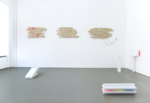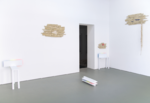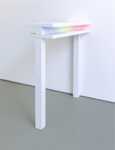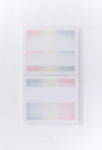Åplus is pleased to announce that for the second time the two Swiss artists Roman Gysin and Patric Sandri created an exhibition at the gallery. For this new season - according to the ambiguous exhibition title - the two artists have proposed an exhibition concept based on dialogue: Their collaboration started long before the exhibition began, with a conversation that lasted several weeks and now found its form at Åplus in the dialogical juxtaposition of the works.
Roman Gysins (*1984, lives and works in Zurich) artistic work is based on the confrontation with Materials and objects of daily use, their properties, potential, effects and immanent valuations. On a theoretical level, his material and object studies lead to thoughts on commonalities and boundaries between art and decoration, and on topics such as Artificiality and Camp. His work process is based on multi-level, manually executed Transformation processes. He processes his chosen materials, alienates and re-contextualizes them, then transforms them into sculptural objects and arrangements. Their interpretational contexts are vague and undefined, thus prompting new interpretations of what is already familiar.
For the exhibition Neue Staffel, Gysin develops a new series of works. The first step is the processing of wood, which begins with a specially made Gertel. It is a tool used for work in agriculture and forestry, but also in viticulture and horticulture. After processing the wood fragments individually, he coats them with fabric, which he then treats with a mixture of glue and chalk. Monetized in a staggered arrangement on the walls, they mime a fragmentary brickwork like backdrops and transform into wall objects. Objects such as ropes and braids are clamped and hung on these; metal fittings and loops are attached and decorated with bodices.
Characteristic of Gysin‘s works is an ambivalence, which is created by a permanent oscillation of various attributions of meaning and the complexity of the inserted signs.
The artist consciously plays with materialities, textures and contexts, whose inclination towards fluid definitions resists schematic dichotomies.
In his works Patric Sandri (*1979, lives and works in Zurich) explores the medial and formal conditions of painting, space and sculpture, with which he explores the discourse of perception and seeing, and the references between art and design. Each work begins with a systemic principle defined by the artist. Based on the spatial conditions, he defines the relationship of the central recurring components of his works to each other - wood, canvas, and the primary colours yellow, red, blue - in every detail of the execution up to positioning in the room. This results in works that are on the one hand monochrome paintings, but can also be understood as sculptural wall elements. The special neon pigmentation chosen by the artist - neon pigments are larger than other colour pigments and therefore create a real luminosity of their own - they form a colorfield that opens up another level of objecthood.
For the exhibition Neue Staffel an extensive series of sculptural works was created for the first time. For this Sandri works again with a systemic principle. The starting point of all works shown is 3 wooden sticks, 2 wooden panels of equal length and neon pigments in yellow, red and blue. With this fixed set, a kind of fragmentary modular construction kit, the artist plays with the various possibilities of combination. Out of this, he creates settings that remain ambiguous in their appearance and functionality. Despite the strict self-imposed guidelines, fragile-looking objects emerge from, which look like personalized characters playfully balance between equilibrium and imbalance. As if by themselves, they shine and reflect light from seemingly unknown origins. While Sandri‘s earlier works are strongly committed to monochrome painting and minimal art, this series opens a new chapter in his work with which a poetic moment enters his practice and expresses the fragility of the life surrounding us.
Text: Cornelia Huth














